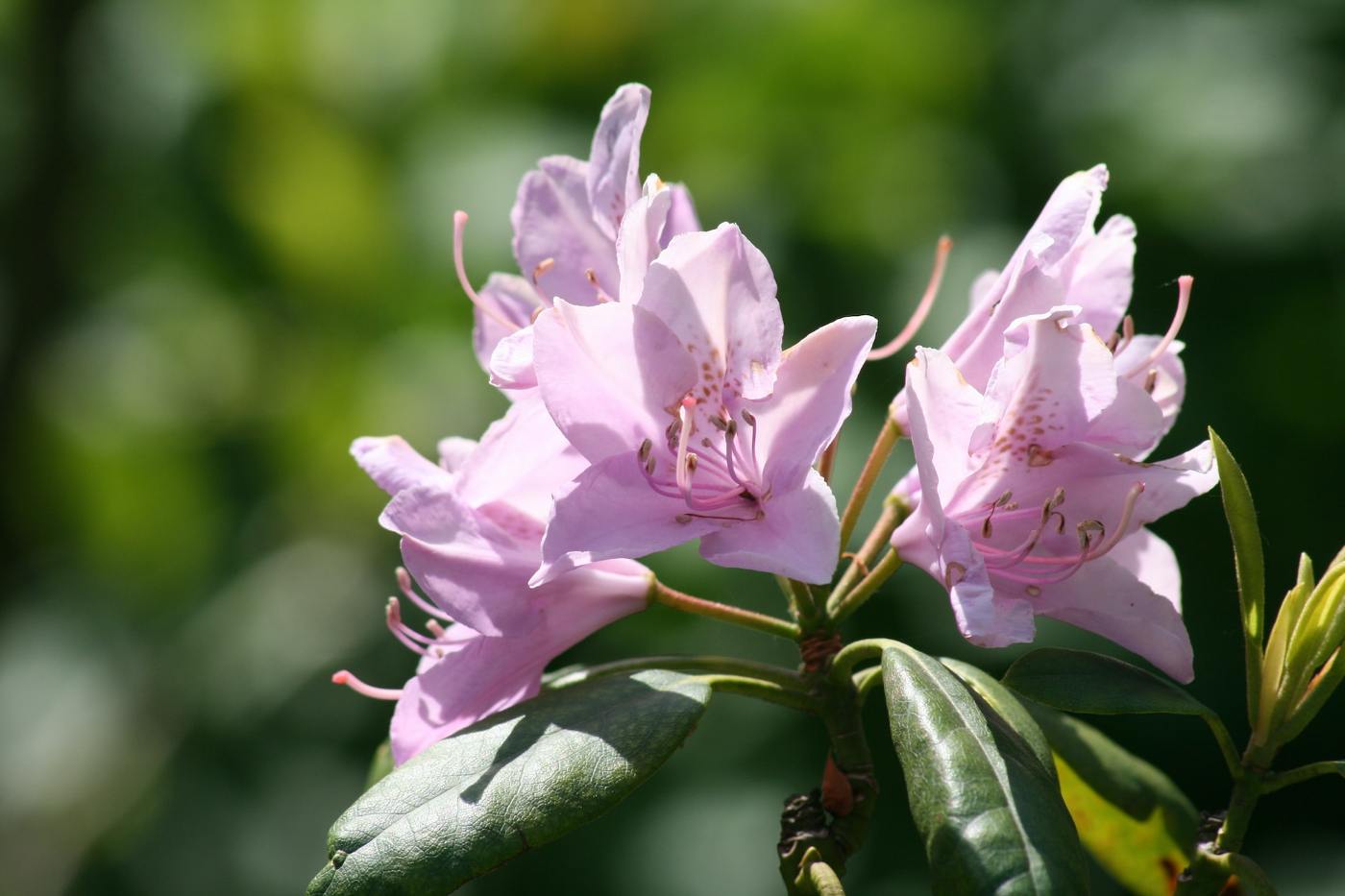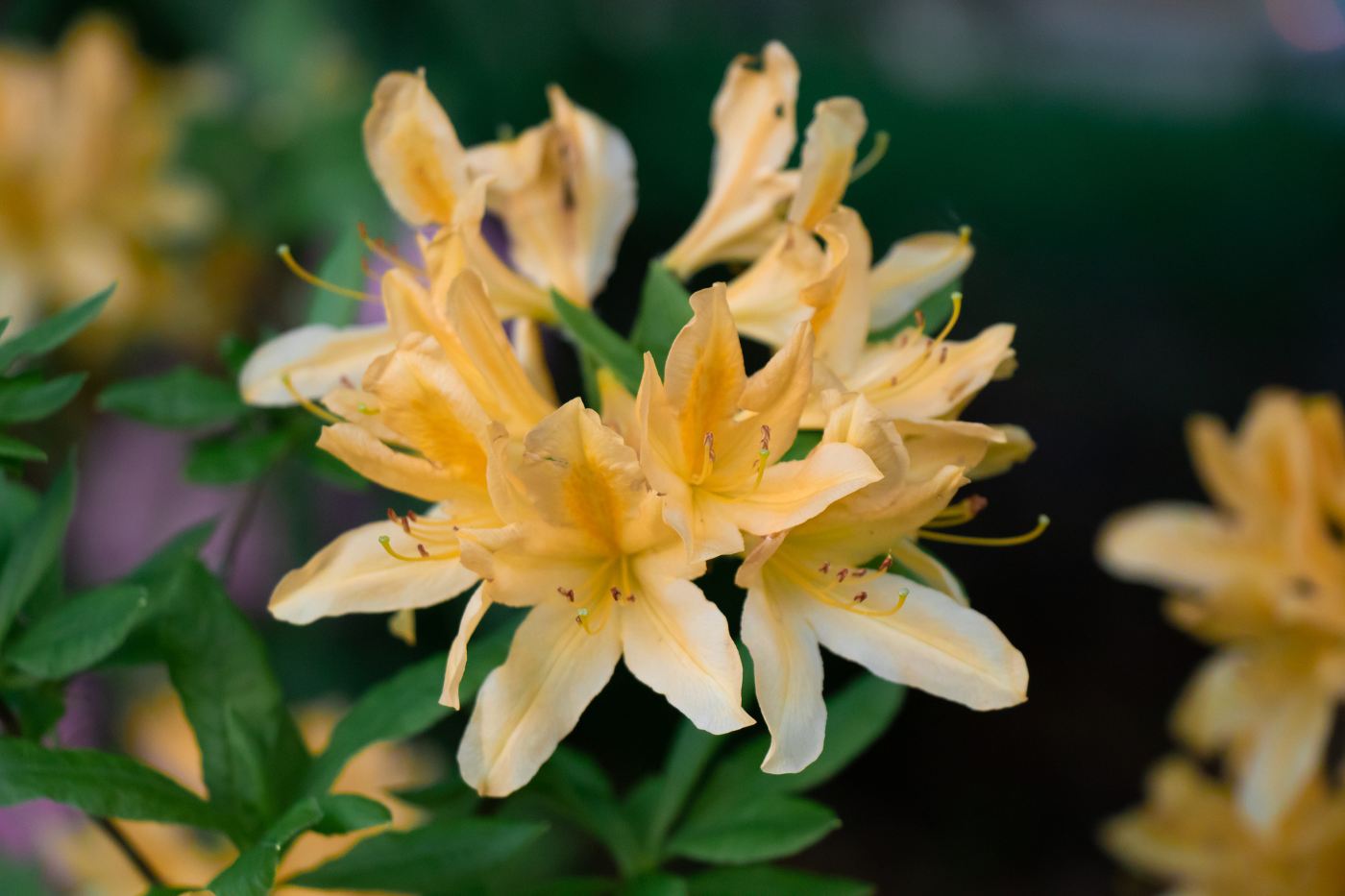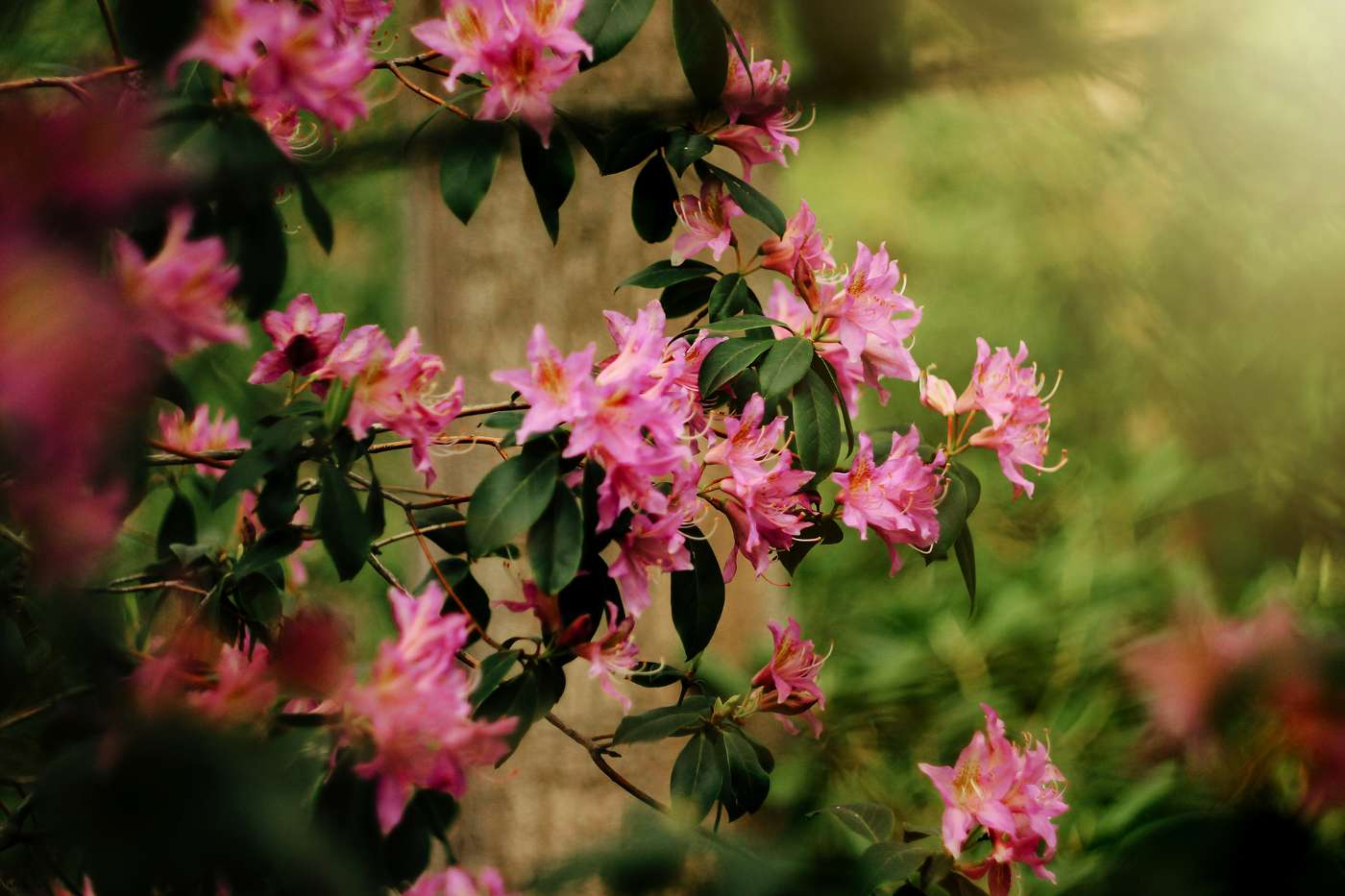Native azaleas are deciduous shrubs belonging to the genus Rhododendron, and are beloved wherever they grow. They are dramatic bloomers whose flowers are as widely known for their fragrance as for their beauty.
This post will introduce you to different types of azaleas that are native to the southeastern U.S. Then we’ll explain how to care for a native azalea in your own home garden.
We’ll finish with a series of frequently asked questions that folks tend to have about these gorgeous flowering shrubs.
Types of Native Azaleas
This list is not exhaustive, but it does feature some of our favourites. We’ve organized it alphabetically by common name to give it some order.
Alabama azalea (R. alabamense) blooms in mid-April, featuring white flowers with a striking yellow blotch. A smaller species, it grows a reasonable 2-6 feet tall. As the name suggests, it’s primarily an Alabama native, but it also grows wild in Georgia and Florida, as well as Tennessee.
Coastal azalea (R. atlanticum) is an early bloomer, flowering in early April with lovely white blooms tinged with pink and sometimes with a yellow blotch. This low-growing species only reaches 1-5 feet tall and can be found all along the eastern seaboard of the U.S.
Cumberland azaleas (R. cumberlandense) are named for the Cumberland Plateau of Kentucky and Tennessee where they grow, although they can also be found in mountainous regions of North Carolina, Georgia and Alabama. They bloom late—in June—with bright orange and pink blossoms. They can grow from 3-7 feet tall.
Rare native azaleas include Eastman’s azalea, also known as May White azalea (R. eastmanii), which is only native to South Carolina. It blooms in May and features white flowers with a pretty yellow splash. A smaller species, it grows from 3-5 feet tall.
The flame azalea (R. calendulaceum) is a May bloomer with big blossoms in shades of yellows, oranges and reds. The shrub itself is also big, growing from 12-15 feet. This lovely grows in the Appalachians, from Pennsylvania to Georgia.
One of the most popular native Florida azaleas is R. austrinum, or the Florida flame azalea. It’s a favourite among folks who love native azaleas in orange, yellow or gold. You’ll also find this species in southern areas of Mississippi, Alabama and Georgia. This species is a very early bloomer, flowering in late March or early April. It can reach 15 feet tall.
And one of the most vibrant Georgia and South Carolina native azaleas is the Oconee azalea (R. flammeum). You might hear this species referred to by its earlier name, R. speciosum, as well. This species blooms in April with flowers ranging from yellow to orange to red. It reaches 6-8 feet tall.
Piedmont azalea (R. canescens) is common throughout the southeastern states and can be found as far west as Texas. It blooms in early April and has pale pink to white flowers. A large shrub, it grows from 10-15 feet tall.
Pinkshell azaleas (R. vaseyi) are rare pink native azaleas that grow wild in the mountains of North Carolina. They grow tall—from 10 to 15 feet—and they bloom in April.
Pinxterbloom azaleas (R. periclymenoides) bloom in mid-April. Their flowers can range from white to deep pink. This shrub grows from 3-8 feet tall, and is widespread, growing from Alabama up to New England.
Plum leaf azaleas (R. prunifolium) are native to Alabama and Georgia. These shrubs are tall, reaching 15 feet, and striking in oranges and bright reds. They bloom quite late, beginning in late June or even as late as September.
Roseshell azaleas (R. prinophyllum, formerly R. roseum) feature light pink to purplish blooms that appear in May. The shrub grows from 6-12 feet tall. Its distribution is very wide, ranging from southern Québec, Canada down the eastern U.S. and west to Texas.
Sweet azalea (R. arborescens) produces white to pink flowers in June. This is a large shrub that can get up to 15 feet tall. Its range is large. You can find it growing wild from Alabama all the way to New York state. It’s one of the most beloved native azaleas in North Carolina.
The swamp azalea (R. viscosum) can reach anywhere from 3 to 15 feet tall. It flowers starting in the middle of May and features white flowers with a slight pinkish hue. This common shrub grows all the way from New England to Florida and its range stretches west to Oklahoma and Texas.
Native Azaleas Care
Site selection is the most important thing about caring for an azalea because they hate to be moved once they’re planted. Choose a site that suits the species of azalea you have—some prefer dry conditions and some have evolved to thrive in swampier soil. Do a bit of research before you plant to give your azalea the best chance of success.
Plant your azalea someplace where it can have morning sun and afternoon shade, as these plants don’t thrive in the heat. The more north you are, the more sun your azalea will be able to take.
Azaleas prefer acidic soils—if your soil isn’t acidic, mix some composted pine bark or peat moss into the soil as you loosen it to plant.
This won’t be welcome advice, but try to dig a hole that’s a foot deeper than you need for your azalea. That will let you aerate the soil and mix in materials that will keep it lighter and better draining, which your plant will thank you for.
Once your azalea is planted, consider adding a layer of pine mulch over the disturbed soil, being careful not to bank the mulch up against the trunk of the shrub. Water deeply as soon as the azalea is planted. Then water every 2-3 days until the plant is established.
Established plants should be watered only when the soil begins to dry out. In hot locations, that could be anywhere from 3 to 14 days, depending on temperature, humidity, how shady your garden is and how well-draining your soil is.
One of the most frequent mistakes people make with azaleas is overwatering. Most azaleas hate being soggy, so if you’re not sure, feel the soil with your hand (under the mulch if necessary) and only water if the soil is dry to the touch.
Fertilize your azalea in the spring with an acid forming, 2-1-1 fertilizer. There are several fertilizers on the market specifically for rhododendrons and azaleas, but any high-quality fertilizer that matches their needs will do.
FAQ
Where are azaleas native?
Azaleas are native to eastern North America from Florida up to Maine. They also grow naturally in temperate regions of Europe, China, Japan and Korea.
When do native azaleas bloom?
Native azaleas are spring bloomers, with some blooming in April and some as late as June, depending on species.
Where to plant native azaleas
Plant your azalea in a cool, partially shaded spot. Ideally, the planting site will get morning sun and afternoon shade. Soil should be rich, well-draining, moist and acidic, with a pH somewhere between 4.5 and 6.0.
Why won’t my native azaleas bloom?
Pruning too late in the season and accidentally removing growing flower buds is a common cause. Heavy frosts and freezing can also damage flower buds. Your native azaleas could be struggling with soil that’s too wet or too dry for the particular needs of its species—check the growing conditions required by the species you have.
Your azaleas could simply be too young to flower and might need more time to mature. Alternatively, if a shrub flowered heavily last year, it might take a rest this year or for a few years. Finally, a lack of sunlight could be a contributing factor.
When to prune native azaleas
You don’t need to prune them. Native azaleas are intended to have a loose, open shape that differs from cultivated azaleas. If you do need to cut them back, prune after the blooms are spent but before new buds form.
Do deer eat native azaleas? Are native azaleas deer resistant?
Unfortunately, azaleas are not deer resistant. In fact, deer seem to really like them. This is not to say that you shouldn’t plant azaleas if you have deer, but that you will need additional protection such as fencing to keep them safe.
Feature image: Tina Xinia; Image 1 and 2: Depositphotos


